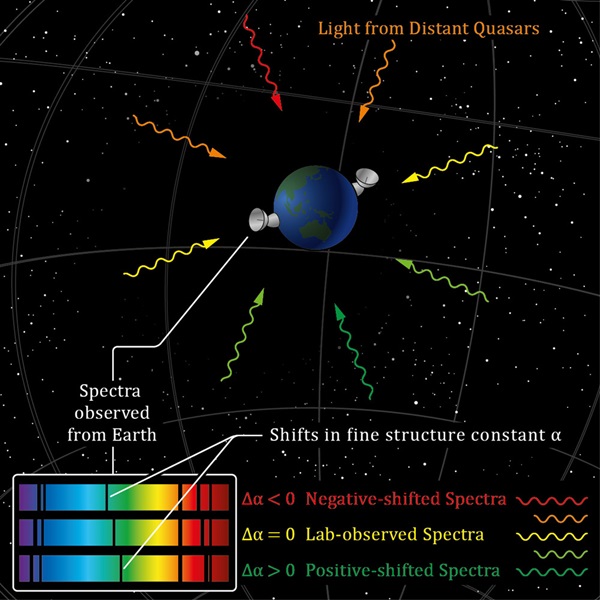Key Takeaways:
New research suggests that the supposedly invariant fine-structure constant, which characterizes the strength of the electromagnetic force, varies from place to place throughout the universe. The finding could mean rethinking the fundaments of our current knowledge of physics. These results were presented September 7 during the Joint European and National Astronomy Meeting in Lisbon, Portugal, and the scientific article has been submitted to the Physical Review Letters Journal.
A team of astronomers led by John Webb from the University of New South Wales, Australia, has obtained new data by studying quasars, which are very distant galaxies hosting an active black hole in their center. As the light emitted by quasars travels throughout the cosmos, part of it is absorbed by a variety of atoms present in interstellar clouds, providing astronomers with a natural laboratory to test the laws of physics billions of light-years away from Earth.
Webb’s results imply that the fine-structure constant, which characterizes the strength of the electromagnetic force, might have different values depending on which direction scientists are looking in the sky, thus being not so “constant” after all.
“The precision of astrophysical measurements of the fine-structure constant, or alpha, dramatically increased about a decade ago when Victor Flambaum and I introduced the ‘Many-Multiplet Method,’ and since then evidence started mounting, suggesting this crucial physical quantity might not be the same everywhere in the universe,” said Webb.
The results obtained by Webb’s team suggest that if there is any time variation, it may be much less than the variation with position in the universe. If correct, the new data indicates that new physics will be required to explain something so fundamental. The implications of these results are so resounding that they are likely to cause controversy in the scientific community.
Using two world-class observatories, the Keck Telescope and the European Southern Observatory’s Very Large Telescope, Webb and his team observed the very energetic radiation coming from the most luminous objects in the universe: quasars. Although quasars are incredibly far away, scientists can detect them from Earth due to the sheer quantity of electromagnetic radiation that they emit, likely caused by material falling into supermassive black holes at their centers.
“The interaction of the light from the quasars with the gas clouds provides an impressive opportunity to investigate the physical conditions when the Universe was just a fraction of its current age,” said Ph.D. student Julian King, who played a major role in this research. “It is exciting that we have the technology to be able to measure the laws of physics in the early universe so precisely.”
The new results collected by Webb and his team can be explained if our universe is in fact exceptionally or indeed infinitely large, with fundamental quantities and “constants” possessing different values from patch to patch. In such a scenario, we would exist in just a tiny part with correspondingly small changes in the physical constants.
This view raises a whole series of new questions on how “alpha” and the other “constants” have been so finely-tuned, in our local patch of the universe, to develop physics and chemistry as we know them, and along them, life on Earth.









